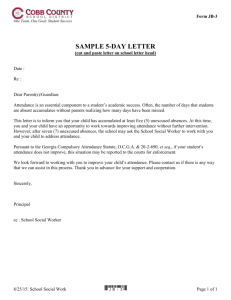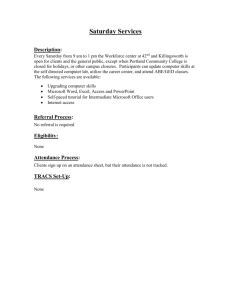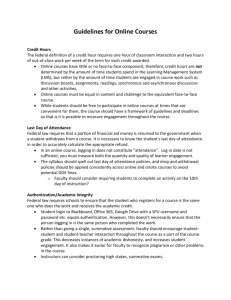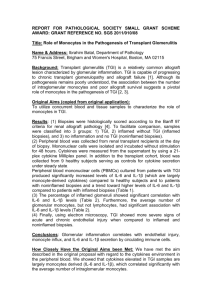Please enter name here
advertisement
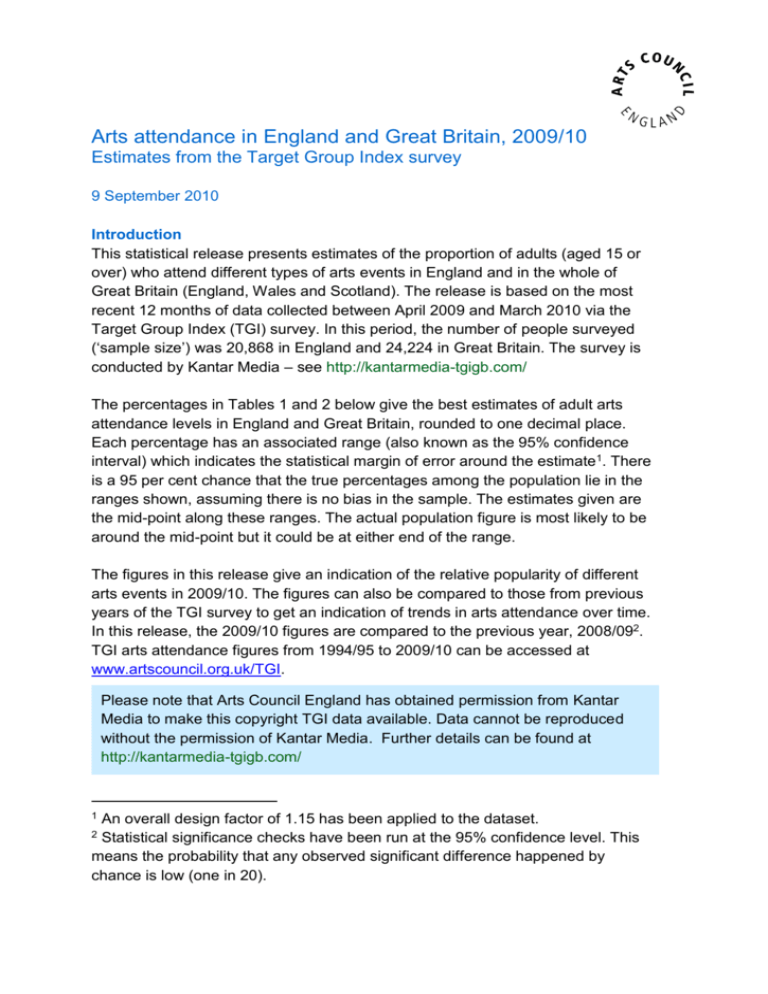
Arts attendance in England and Great Britain, 2009/10 Estimates from the Target Group Index survey 9 September 2010 Introduction This statistical release presents estimates of the proportion of adults (aged 15 or over) who attend different types of arts events in England and in the whole of Great Britain (England, Wales and Scotland). The release is based on the most recent 12 months of data collected between April 2009 and March 2010 via the Target Group Index (TGI) survey. In this period, the number of people surveyed (‘sample size’) was 20,868 in England and 24,224 in Great Britain. The survey is conducted by Kantar Media – see http://kantarmedia-tgigb.com/ The percentages in Tables 1 and 2 below give the best estimates of adult arts attendance levels in England and Great Britain, rounded to one decimal place. Each percentage has an associated range (also known as the 95% confidence interval) which indicates the statistical margin of error around the estimate1. There is a 95 per cent chance that the true percentages among the population lie in the ranges shown, assuming there is no bias in the sample. The estimates given are the mid-point along these ranges. The actual population figure is most likely to be around the mid-point but it could be at either end of the range. The figures in this release give an indication of the relative popularity of different arts events in 2009/10. The figures can also be compared to those from previous years of the TGI survey to get an indication of trends in arts attendance over time. In this release, the 2009/10 figures are compared to the previous year, 2008/092. TGI arts attendance figures from 1994/95 to 2009/10 can be accessed at www.artscouncil.org.uk/TGI. Please note that Arts Council England has obtained permission from Kantar Media to make this copyright TGI data available. Data cannot be reproduced without the permission of Kantar Media. Further details can be found at http://kantarmedia-tgigb.com/ 1 An overall design factor of 1.15 has been applied to the dataset. Statistical significance checks have been run at the 95% confidence level. This means the probability that any observed significant difference happened by chance is low (one in 20). 2 Key findings The highest proportion of people reported attending cinema, any performance in a theatre and plays in 2009/10 (in England 67.5%, 48.8% and 33.3% of all adults respectively) In comparison with 2008/09, in 2009/10 there was a statistically significant decrease in attendance at ballet and jazz events in England and the whole of Great Britain, and in opera and classical music in Great Britain. The only type of event where attendance increased from 2008/09 to 2009/10 was cinema (in England from 64.7% in 2008/09 to 67.5% in 2009/10). There was no statistically significant change in the attendance levels in England or Great Britain at any theatre performance, plays, contemporary dance, and art exhibitions from 2008/09 to 2009/10. The TGI arts attendance questions The TGI questionnaire asks people about their attendance at ten different types of arts events: 1) any performance in a theatre; 2) plays; 3) opera; 4) ballet; 5) contemporary dance; 6) classical music concerts or recitals; 7) jazz concerts or performances; 8) other music concerts in stadiums/arenas 9) other music gigs 10) art galleries or art exhibitions; and 11) cinema. The question asks the respondents ‘About how often these days do you go to the following’ [events], with the available answer categories including: 1) once a month of more often; 2) once every two or three months; 3) two or three times a year; 4) once a year; 5) less often; and 6) never go these days. The arts attendance percentages in this release give the combined proportion of respondents who reported going at any frequency (1–5). The percentages therefore include people who go less than once a year but still consider themselves as going ‘these days’. For this reason, as well as for differences in sampling and survey methodology, the figures in this release are not comparable to statistics from the Taking Part survey (see www.artscouncil.org.uk/takingpart). Taking Part is a continuous face-to-face survey of English adults aged 16 and over, commissioned by the Department for Culture, Media and Sport in partnership with the Arts Council and other cultural agencies, that provides statistics on the respondents’ cultural and sport participation in the 12 months prior to interviewing. Arts attendance estimates from Target Group Index survey 2009/10 Table 1 England: percentage of adults attending arts events, 2009/10 Arts event type Percentage Range (%) Any performance in a theatre 48.8 +/- 0.8 Plays 33.3 +/- 0.7 Opera 8.5 +/- 0.4 Ballet 9.5 +/- 0.5 Contemporary dance 8.9 +/- 0.4 Classical music concerts or recitals 16.9 +/- 0.6 Jazz concerts or performances 10.9 +/- 0.5 3 Other music concerts in stadiums/arenas 8.2 +/- 0.4 Other music gigs 7.4 +/- 0.4 Arts galleries or art exhibitions 29.8 +/- 0.7 Cinema 67.5 +/- 0.7 Sample size: 20,868 The ranges provide 95% confidence intervals around the estimates. Note that percentages include people who attend less often than once a year. Source: Target Group Index Kantar Media 2010 Table 2 Great Britain: percentage of adults attending arts events, 2009/10 Arts event type Percentage Range Any performance in a theatre 48.2 +/- 0.7 Plays 32.5 +/- 0.7 Opera 8.3 +/- 0.4 Ballet 9.3 +/- 0.4 Contemporary dance 8.6 +/- 0.4 Classical music concerts or recitals 16.5 +/- 0.5 Jazz concerts or performances 10.7 +/- 0.4 Other music concerts in stadiums/arenas 8.1 +/- 0.4 Other music gigs 7.5 +/- 0.4 Arts galleries or art exhibitions 29.7 +/- 0.7 Cinema 66.8 +/- 0.7 Sample size: 24,224 The ranges provide 95% confidence intervals around the estimate. Note that percentages include people who attend less often than once a year. Source: Target Group Index Kantar Media 2010 3 “Other music concerts in stadiums/arenas” and “Other music gigs” replaced “popular/rock concerts” from Q1 (January) 2010. Therefore there are no comparable figures for these two categories from any previous year of the TGI survey. About the Target Group Index The Target Group Index is a national survey of adults aged 15 or over living in Great Britain, conducted by Kantar Media. It is recognised as a major source of information by advertisers, advertising agencies and media owners. Each year it collects information from a sample of around 25,000 adults aged 15 or over in England, Wales and Scotland. Major islands, such as the Isles of Wight and Bute are included, but smaller off-shore islands such as Orkney, Shetland and the Hebrides are excluded from the survey. The information is obtained through a self-completion questionnaire. Around 2,000 respondents fill in a questionnaire each month. Most respondents filled in a paper questionnaire, although since 2007 people have had the option to fill the questionnaire in online. In 2009/10 4,178 respondents (17.2%) chose to fill in the questionnaire online. The respondents are recruited from among people who have been interviewed for Kantar’s Face-to-Face Omnibus4. The Face-to-Face Omnibus is a weekly survey of adults across Great Britain. In 2009/10, a total of 83,492 attempts were made at the end of Face-to-Face Omnibus interviews to place a TGI questionnaire. Of these, 24,224 people returned a useable questionnaire, giving an overall response rate of 29.0%. The achieved sample was then weighted in two stages. The first stage was demographic weighting by age, region, social class and gender, to adjust for over and undersampling among different demographic groups. This weighting was based on population estimates from the Census, the Establishment Survey published by BARB and the National Readership Survey. The second stage of weighting was based on newspaper and magazine readership data in TGI and the National Readership Survey. For titles measured in both surveys, the readership levels in the TGI sample were adjusted to align with those observed in the National Readership Survey, within age (15-24, 25-34, 3554, 55+), gender and social class (AB, C1, C2, DE). For each respondent, an overall weight factor was finally calculated on the basis of their first-stage weight, readership factors and demographic characteristics. 4 TGI therefore inherits the sample design of the Omnibus survey. More detail on the sample design is available on request from takingpart@artscouncil.org.uk. Potential sources of error Despite the weighting, the figures may not provide accurate estimates of arts attendance among the entire population in England or Great Britain, due to nonresponse bias. Those people who filled in the TGI questionnaire might not be representative of their age group, gender, social grade or region as far as arts attendance patterns are concerned. Therefore, even when the TGI sample is weighted to be representative of the whole population in demographic terms, it might not give an accurate picture of arts attendance levels among the whole population. TGI estimates – like all population estimates based on a sample – are also associated with a standard statistical error, indicated by the confidence interval.

